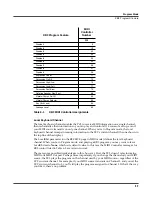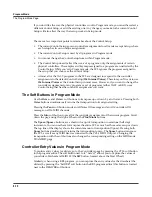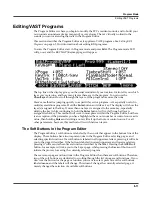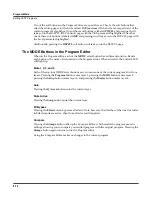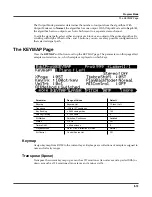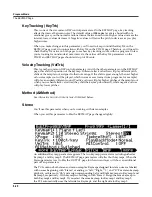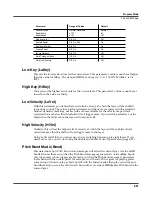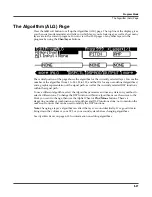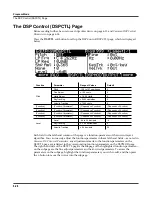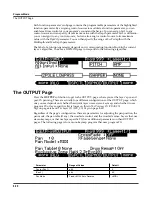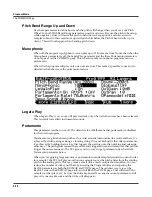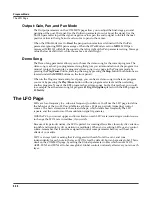
Program Mode
The KEYMAP Page
6-21
Once you have the keymaps assigned, go to the OUTPUT page and set the panning for each
sample as desired. Keep in mind that using stereo keymaps reduces the polyphony of the
program. For example, if you had a two-layer program with stereo keymaps in each layer, each
note you play would use 4 of your 128 voices, allowing a total of 32 notes before all the voices
have been used.
If you’re not using stereo samples, you should set this parameter’s value to
Off
.
Timbre Shift
This parameter works only on multi-sample keymaps, and changes the root selection for each
key you play. With this parameter you can radically alter the current layer’s timbre (basic sound
characteristics). The nature of the change depends on the timbre itself, so this parameter calls for
experimentation. Basically, timbre shifting changes a note’s timbre by imposing different
harmonic qualities onto the note. A timbre-shifted note retains its original pitch, but its
harmonics are those of the same timbre at a higher or lower pitch. Positive values for this
parameter tend to brighten a sound, while negative values darken.
Here’s an example. If you shift the timbre up 4 semitones, then playing C 4 will result in the
pitch
C 4, but will actually play the sample normally assigned to G
#
3, and shift its pitch up four
semitones. This will increase the playback rate of the sample, so although the pitch remains
normal, the timbre is brighter. You’d get the same effect by setting the Xpose parameter on the
KEYMAP page to
-4 semitones
, then setting the Adjust on the PITCH page to
+4 semitones
. For
multi-sample layers with narrow key ranges, large amounts of timbre shifting will cause
different sample roots to be played back.
Playback Mode
This gives you numerous options for manipulating the samples in the current layer as you
trigger them.
Normal
leaves the samples unaffected, while
Reverse
plays them in reverse. At a
value of
Reverse
, the samples will continue to loop as long as notes are sustained. To play them
just once in reverse, you would adjust the length of the layer’s amplitude envelope (explained
later in this chapter).
BiDirect
(bidirectional) causes the samples to loop infinitely, alternating
between normal and reversed playback.
Noise
replaces the samples with a white noise
generator.
Alternative Controller (AltControl)
See
Alternative Switch (AltControl and AltMethod)
below.
Alternative Switch (AltControl and AltMethod)
Many, but not all, PC3 sample roots have been pre-assigned a carefully chosen, fixed alternate
sample start or end point that can be selected using the Alternate Switch feature
(altControl
and altMethod parameters). This feature allows you to control the sample playback start/end
time triggered by any control source.
Use the AltControl parameter to specify a control source that will cause the sample to begin or
end at the Alt point. Then use the AltMethod parameter to choose between switched and
continuous calculation of the Alt point. If the value of AltMethod is
Switched
, the PC3 will use
the Alt point when the relevant control source is at a value greater than 64 at Note Start. If
AltMethod is
Continuous
, the Alt point will vary depending on the value of the relevant control
source at Note Start.
Содержание PC3
Страница 24: ...1 6 Introduction Options ...
Страница 50: ...4 4 The Operating Modes Using the Modes ...
Страница 174: ...7 54 Setup Mode The Utility Soft Buttons ...
Страница 178: ...8 4 Quick Access Mode Making Your Own QA Banks ...
Страница 204: ...9 26 Effects Mono Algorithms ...
Страница 266: ...A 2 MIDI Implementation Chart ...
Страница 308: ...Index x ...

